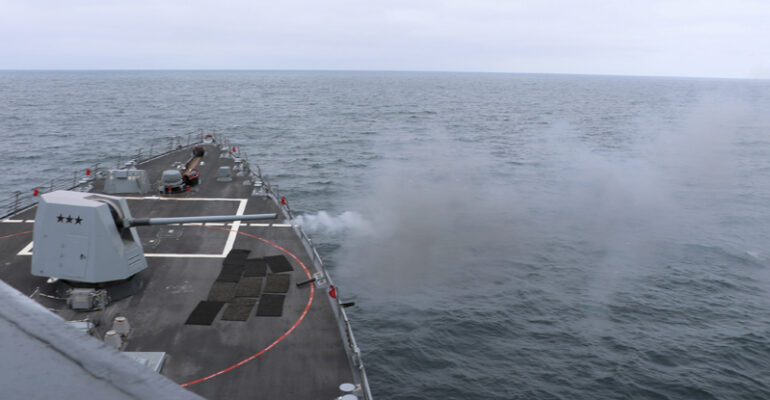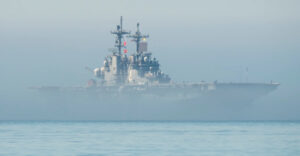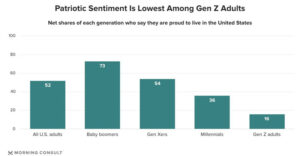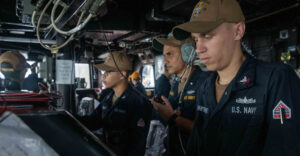Navy Missiles and the Defense of Taiwan: Part 2
29 April 2024 2024-05-18 16:46Navy Missiles and the Defense of Taiwan: Part 2
By Capt Brent Ramsey, US Navy ret
For the People’s Republic of China’s (PRC) plan to conquer Taiwan to succeed, the Chinese need to keep American aircraft carriers away. They will threaten our carriers with massive barrages of anti-ship missiles. The PRC’s DF-26 anti-ship ballistic missile is a legitimate threat, described in more detail in the American Interest. Its range exceeds 3,100 miles, it is highly maneuverable, and it can carry either nuclear or conventional warheads. Entering service in 2018, it is mature technology, and China is believed to have at least 500 of them.
According to the Congressional Research Service’s report titled “China Naval Modernization: Implications for U.S. Navy Capabilities — Background and Issues for Congress”: “China is fielding two types of land-based ballistic missiles with a capability of hitting ships at sea at extended ranges — the DF-21D, a road-mobile anti-ship ballistic missile (ASBM) with a range of more than 1,500 kilometers (i.e., more than 810 nautical miles), and the DF-26, a road-mobile, multi-role intermediate range ballistic missile (IRBM) with a maximum range of 3,000 kilometers to 4,000 kilometers (i.e., about 1,620 nautical miles to 2,160 nautical miles) that DOD says ‘is designed to rapidly swap conventional and nuclear warheads and is capable of conducting precision land-attack and anti-ship strikes in the Western Pacific … from mainland China.’”
The report also says, “China reportedly is developing hypersonic glide vehicles that, if incorporated into Chinese ASBMs, could make Chinese ASBMs more difficult to intercept.”
The report quotes “a February 2, 2023, press report” that states, “For the first time, the PLA has officially revealed the performance of its advanced anti-ship hypersonic missile, sending a warning to the US amid high tensions in the Taiwan Strait, Chinese analysts said. China’s YJ-21, or Eagle Strike-21, has a terminal speed of Mach 10, cannot be intercepted by any anti-missile weapons system in the world and can launch lethal strikes towards enemy ships, according to an article posted by the official Weibo account of the People’s Liberation Army Strategic Support Force.”
The PRC has large numbers of anti-ship cruise missiles as well. With these troubling reports of the PRC’s arsenal of anti-ship missiles, will the U.S. risk our capital ships and thousands of lives in the defense of Taiwan?
The Navy has a family of missiles specifically designed to intercept anti-ship missiles. These are the SM-2, the SM-3, and the SM-6. The SM-2 missile is designed to engage high-speed, high-altitude, and anti-ship cruise missiles. The SM-3 is used to destroy short- to intermediate-range ballistic missiles. The interceptor uses sheer force rather than an explosive warhead to destroy targets in space. The SM-6 is a multi-mission missile capable of antiair warfare, terminal ballistic missile defense, and anti-ship strike roles. It uses a blast-fragmentation warhead to engage these threats at high altitudes short of space.
These are all used with an advanced radar control system and a versatile launch system, the Mark 41 Vertical Launch System (VLS). These missiles have been successfully tested and are deemed reliable. Some of these missiles have been used in Israel’s recent defense with great success. In addition, all our ships have closer-range defense systems such as the close-in weapons system (CIWS), the RIM-162 Evolved Sea Sparrow missile, 5″ guns, and 50 caliber machine guns. These are best described as last-resort defensive systems.
Burke-class destroyers have either 90 or 96 cells in their Vertical Launch System. Ticonderoga-class cruisers have 122 cells. The Navy has large numbers of Burke-class destroyers (~70) and a few cruisers (13) (three are in long-term maintenance and may never rejoin the fleet). Zumwalt-class destroyers are presumed to be not a factor. We currently have two carriers and one Amphibious Assault ship in the Pacific. As tensions rise, the number would likely increase. Even for our capital ships, the number of escorts is small. Hypothetically, each carrier could have up to three or four escorts to protect them. Since the escorts carry a weapons loadout that includes many types of missiles, only a portion of the cells contain anti-missile missiles; the rest are devoted to land attack, anti-submarine warfare, and other missions.
The danger to our carriers/crews in this scenario is extreme. If the PRC launched hundreds of missiles at our ships simultaneously, our various defense systems would be very hard-pressed to defend those ships. In a war games series reported in 2023, according to Newsweek: “The number of American servicemembers killed, wounded, or missing would near 10,000. The U.S. Navy typically lost two aircraft carriers and up to 20 major surface ships — destroyers or cruisers.”
The Navy has the technology to defeat the PRC in war. What we lack is an adequate number of ships and weapons. Congress has ignored the warning signs of an emerging China and has not provided the ships and weapons we need to uphold national policy. Without the Navy, Taiwan and our treaty allies cannot be adequately defended. Due to the neglect of the Navy, the fate of millions hangs in the balance.
If Taiwan falls, the U.S. will have ceded control of the Pacific to the PRC. Japan, the Philippines, and South Korea will be directly threatened. China will be the hegemon of the Indo-Pacific, and the U.S. Navy will no longer be recognized as the world’s most powerful navy. It is not too late to change this picture. If you agree, urge your congressional representatives to build up our Navy.






























